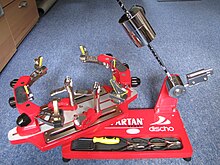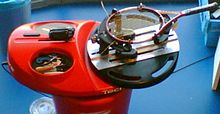Stringing machine
A stringing machine is a device that can be used to re- string tennis , squash and badminton rackets. These machines vary in complexity, accuracy and their price.
Expenditure of time
Stringing a racket can take up to an hour for beginners, whereas experienced stringers can do it in around 20 minutes. During professional tournaments, very experienced stringers are required to string rackets while the player is on the court, which should not take even ten minutes.
Differences in different sports
tennis
Tennis strings are usually made of gut, polyester, or a hybrid of both, although other materials such as nylon, metal thread, and kevlar are also used. The hardness of the covering ranges from 23 to 30 kg. Professional players tend to string their rackets very tightly, with the recent trend towards softer strings.
badminton
Today, badminton strings are mostly made of multifilament, previously made of gut. The tension varies between 8 and 16 kg. Professional players usually string at the upper limit.
squash
Squash strings are usually made of multifilament, gut, or a hybrid of both. The tension varies between 9 and 14 kg.
Types of stringing machines
Lever arm machines
Lever arm machines use a rod with a sliding weight to achieve the desired string tension. They are inexpensive and relatively easy to transport because of their small size, which makes them popular with people starting out with stringing. However, covering them with them takes significantly longer, which makes them unusable for professional use.
Crank machines
Stringing machines with a crank system use a crank to achieve the desired tension at which they then click into place. These machines allow for quick stringing.
Electronic machines
Electronic stringing machines regulate the tension of the string via a computer-aided electric motor, which enables fast work with high precision. Such machines can be found in most stores and are also used in all professional tournaments. This type of stringing machine is by far the most expensive to purchase.
There are two types of electronic clamping devices: constant pull and those with locking. Constant pulling continues to pull even after the desired tension has been reached, thus enabling smoother and more precise stringing as they compensate for things like stretching the string, opening the clamps and slipping the string. Locking electronics are similar to the crank system, pulling to the desired voltage and then no further as they click into place. Locking machines are therefore less accurate.
Web links
Individual evidence
- ↑ Guide to buying a Stringing Machine ( Memento from April 2, 2015 in the Internet Archive )

